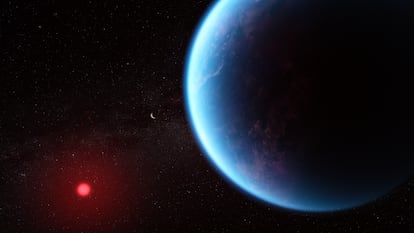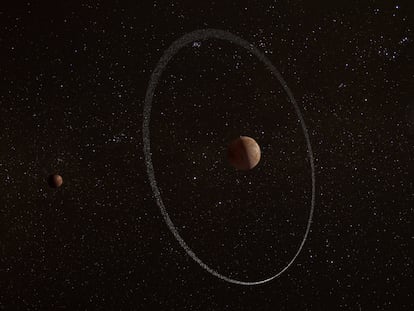An exoplanet that’s 120 light years away from earth shows signs of greenhouse gases. Does that make it habitable?
The presence of CO₂ and methane on K2-18 b – detected by the James Webb Space Telescope – suggests that oceans and an Earth-like atmosphere may exist on this exoplanet. However, more comprehensive data is needed to be able to speak about signs of life

By using the James Webb Space Telescope, an international team has just detected the presence of carbon dioxide and methane on the exoplanet K2-18 b. This world — which is 120 light years from us — is unlike anything in our solar system. It has greater mass than Earth, but less than Neptune.
These types of planets potentially have hydrogen-rich atmospheres and surface areas covered in oceans of water. That’s why they’ve also been called hycean (an acronym for hydrogen and ocean). However, since we have nothing similar nearby to compare to these exoplanets, we don’t know them well enough.
The atmospheres of the hycean planets are relatively simple to characterize. But, still, we have to use the infrared James Webb Telescope that is one million miles from the earth — complemented with data obtained from the Hubble Telescope and various ground-based telescopes —, and even then we’re not sure whether these exoplanets can harbor life. While deciphering the mysteries of the universe is fascinating, nobody said that it was easy.
The abundance of methane and carbon dioxide and the scarcity of ammonia – all detected in K2-18b (which is eight times larger than Earth) – support the hypothesis that it may contain an ocean of water under a hydrogen-rich atmosphere. These observations – which are currently being clarified with more data – also speak of a possible signal from a molecule called dimethyl sulphide (DMS). The signal would have to be confirmed, but on Earth, this molecule is only produced by marine phytoplankton. Scientists urge caution before discussing signs of life.
Both the origin and the evolution of life on our planet are written in the simple carbon atom. It could be said that this chemical element is the basis of the building material that makes up our bodies. But not only that: carbon controls global climate cycles, something that our energy dependence on fossil fuels is altering. Furthermore, it’s a fundamental component of the materials in what our daily technological life is increasingly based on.
Oftentimes, in astrophysics, when we talk about the discovery of new exoplanets, we mention the habitable zone. We define this as a region with a simple characteristic: the possibility of liquid water existing on the surface of the planet. This simple parameter that is related to the distance to the star helps us evaluate the possibility of the existence of extraterrestrial life. This is because of a complex but very revealing observation: on our planet, life needs liquid water, and it is the only place where it has been shown to exist.
Those who know a little more about astrobiology can always argue that this is a very simplistic definition and that it’s not enough to define a habitable zone. This is true. However, as we move away from the Earth, we lose information. Therefore, we have to simplify the parameters that we use to determine the possibility of life. Of course, new telescopes – such as the James Webb – help us not only refine the models, but also make measurements that, just a few years ago, we thought were impossible.
The temperature of the Earth’s surface – one of the most important physical variables in what we broadly call “climate” – is controlled by a series of factors closely linked to each other: solar insolation, albedo and the content of greenhouse gases. What we call solar insolation is what tourists from cold countries learn when they visit the coasts of a sunny nation: simply, the amount of energy that the planet receives from the Sun. It basically depends on changes in luminosity (energy per second over the entire range of wavelengths) emitted by the star and the distance at which the planet is located.
Albedo is simply the part of that energy from the Sun or star that a planet – as a whole – reflects back into space. It’s easy to see how albedo is influenced by clouds, ice layers, vegetation, the amount of land versus ocean on the planet and aerosols (that set of microscopic particles, solid or liquid, that are found suspended in a gas). And all of this, furthermore, varies on different time scales. Hence, climate models are very complex.
The part of the Sun’s energy that isn’t directly reflected by the albedo and returned to space is absorbed by the Earth’s surface and radiated again, in the form of infrared energy. And this is where greenhouse gases come into play. They absorb that infrared radiation, with the overall effect of warming the atmosphere. Thus, if greenhouse gases fall below a certain limit, liquid water could freeze throughout the planet (these gases aren’t bad, in moderation).
On the other hand, if that threshold is exceeded, most of the water turns into vapor, which must have happened to Venus. For most of our planet’s geological history, the dominant greenhouse gas has been carbon dioxide. It has been demonstrated – with experimental measurements – that its concentration is regulated by a kind of internal thermostat, which has allowed the existence of a moderate climate for more than a billion years. It’s also firmly demonstrated that all this is in the process of changing on Earth in the coming years, due to the human injection of this gas into the atmosphere, coming mainly from the burning of fossil fuels.
Stating, therefore, that a planet is habitable without having measurements of its atmospheric composition is a gross simplification in astrophysics and we know it. For this reason, all planetary characterization efforts are focused on the detection of the molecules that dominate atmospheric chemistry, such as carbon dioxide, methane, ozone and water. This is also the reason why we need to know precisely how much energy the star emits in the entire range – not just in the visible range. And that’s why we’re afraid of losing the Hubble Telescope, because at the moment, it’s the only working instrument that allows us to measure the energy of stars in the ultraviolet range.
Sign up for our weekly newsletter to get more English-language news coverage from EL PAÍS USA Edition
Tu suscripción se está usando en otro dispositivo
¿Quieres añadir otro usuario a tu suscripción?
Si continúas leyendo en este dispositivo, no se podrá leer en el otro.
FlechaTu suscripción se está usando en otro dispositivo y solo puedes acceder a EL PAÍS desde un dispositivo a la vez.
Si quieres compartir tu cuenta, cambia tu suscripción a la modalidad Premium, así podrás añadir otro usuario. Cada uno accederá con su propia cuenta de email, lo que os permitirá personalizar vuestra experiencia en EL PAÍS.
¿Tienes una suscripción de empresa? Accede aquí para contratar más cuentas.
En el caso de no saber quién está usando tu cuenta, te recomendamos cambiar tu contraseña aquí.
Si decides continuar compartiendo tu cuenta, este mensaje se mostrará en tu dispositivo y en el de la otra persona que está usando tu cuenta de forma indefinida, afectando a tu experiencia de lectura. Puedes consultar aquí los términos y condiciones de la suscripción digital.
More information
Últimas noticias
Most viewed
- Oona Chaplin: ‘I told James Cameron that I was living in a treehouse and starting a permaculture project with a friend’
- Sinaloa Cartel war is taking its toll on Los Chapitos
- Reinhard Genzel, Nobel laureate in physics: ‘One-minute videos will never give you the truth’
- Why the price of coffee has skyrocketed: from Brazilian plantations to specialty coffee houses
- Silver prices are going crazy: This is what’s fueling the rally











































